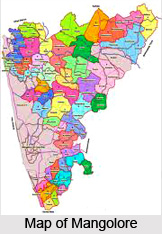 Geography of Mangalore deals with the landforms, rivers and the topography of Dakshina Kannada district of Karnataka.
Geography of Mangalore deals with the landforms, rivers and the topography of Dakshina Kannada district of Karnataka.
Mangalore, the city of trade and commerce, is located at 12.87 degree North to 74.88 degree East in the Dakshina Kannada district of Karnataka.
Mangalore has an average elevation of 22 metres above mean sea level. It is the administrative headquarters of the Dakshina Kannada district, the largest urban coastal center of Karnataka, and the fourth largest city in the state.
Mangalore, the place of forts, palaces and the temples is situated on the west coast of India, and is bounded by the Arabian Sea to its west and the Western Ghats to its east. Mangalore city, as a municipal entity, spans an area of 200 square kilometres. Mangalore experiences moderate to gusty winds during day time and gentle winds at night.
Climate of Mangalore
Mangalore has a tropical monsoon climate and is under the direct influence of the Arabian Sea branch of the southwest monsoon. Mangalore receives about 95 per cent of its total annual rainfall within a period of about six months from May to October, while remaining extremely dry from December to March. The annual precipitation in Mangalore is 3,479 millimetres. The humidity is approximately 75 per cent on average, and peaks during May, June and July. The maximum average humidity is 93 per cent in July and average minimum humidity is 56 per cent in January.
 From December to February, the temperatures during the day time ranges below 30 degree Celsius and drop to about 19 degree Celsius at night. This season is soon followed by a hot summer, from March to May, when temperatures rise as high as 38 degree Celsius. The summer gives way to the monsoon season, when the city experiences more precipitation than most urban centres in India, due to the Western Ghats. The rainfall is about 4,000 millimetres. The rains subsided in September, with the occasional rainfall in October.
From December to February, the temperatures during the day time ranges below 30 degree Celsius and drop to about 19 degree Celsius at night. This season is soon followed by a hot summer, from March to May, when temperatures rise as high as 38 degree Celsius. The summer gives way to the monsoon season, when the city experiences more precipitation than most urban centres in India, due to the Western Ghats. The rainfall is about 4,000 millimetres. The rains subsided in September, with the occasional rainfall in October.
Topography of Mangalore
The topography of the city of Mangalore is plain up to 30 km inside the coast and changes to undulating hilly terrain sharply towards the east in Western Ghats. There are four hilly regions with natural valleys within the city. The geology of the city is characterised by hard laterite in hilly tracts and sandy soil along the seashore. Mangalore is defined as the earthquake prone zone.
Rivers of Mangalore
Mangalore lies on the backwaters of the Netravati River and Gurupura River. These rivers effectively encircle the city, with the Gurupura flowing around the north and the Netravti flowing around the south of the city. The rivers form an estuary at the south-western region of the city and subsequently flow into the Arabian Sea. Mangalore is often used as a staging point for traffic along the Malabar Coast. The coastline of the city is dotted with several beaches, such as Mukka, Panambur, Tannirbavi, Suratkal, and Someshwara.



















